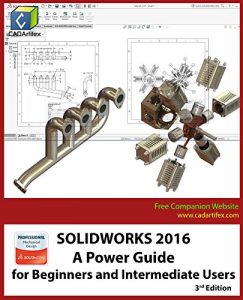SOLIDWORKS 2016: A Power Guide for Beginners and Intermediate Users textbook is designed for instructor-led courses as well as for self-paced learning. This textbook is intended to help engineers and designers who are interested in learning SOLIDWORKS for creating 3D mechanical designs. It will be a great starting point for new SOLIDWORKS users and a great teaching aid in classroom training. This textbook contains 13 chapters which consist of 758 pages covering major environments of SOLIDWORKS: Part, Assembly, and Drawing, which teaches you how to use the SOLIDWORKS mechanical design software to build parametric models and assemblies, and how to make drawings of parts and assemblies. Every chapter of this textbook contains tutorials which intend to help users to experience how things can be done in SOLIDWORKS step by step. Moreover, every chapter ends with hands-on test drives which allow users to experience themselves the ease-of-use and powerful capabilities of SOLIDWORKS.
Table of Contents:
Chapter 1. Introduction to SOLIDWORKS
Chapter 2. Drawing Sketches with SOLIDWORKS
Chapter 3. Editing and Modifying Sketches
Chapter 4. Applying Geometric Relations and Dimensions
Chapter 5. Creating First/Base Feature of Solid Models
Chapter 6. Creating Reference Geometries
Chapter 7. Advanced Modeling - I
Chapter 8. Advanced Modeling - II
Chapter 9. Patterning and Mirroring
Chapter 10. Advanced Modeling - III
Chapter 11. Working with Assemblies - I
Chapter 12. Working with Assemblies - II
Chapter 13. Working with Drawing
Table of Contents:
Chapter 1. Introduction to SOLIDWORKS
Chapter 2. Drawing Sketches with SOLIDWORKS
Chapter 3. Editing and Modifying Sketches
Chapter 4. Applying Geometric Relations and Dimensions
Chapter 5. Creating First/Base Feature of Solid Models
Chapter 6. Creating Reference Geometries
Chapter 7. Advanced Modeling - I
Chapter 8. Advanced Modeling - II
Chapter 9. Patterning and Mirroring
Chapter 10. Advanced Modeling - III
Chapter 11. Working with Assemblies - I
Chapter 12. Working with Assemblies - II
Chapter 13. Working with Drawing






